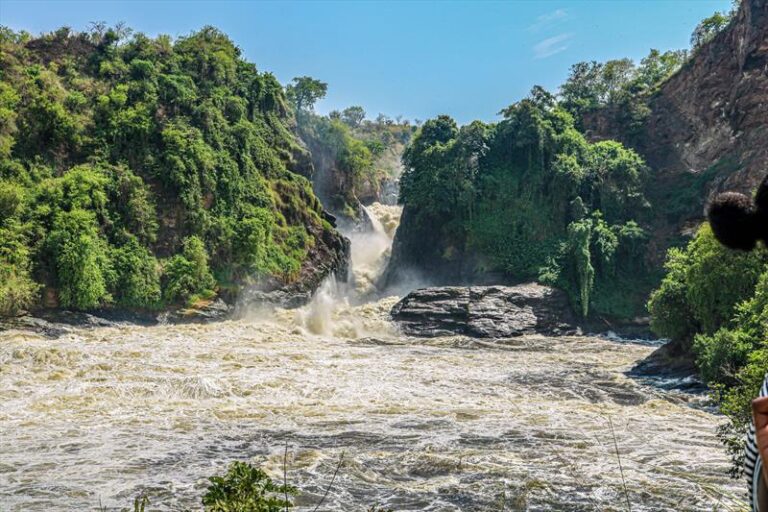MURCHISON FALLS NATIONAL PARK
Murchison Falls National Park is Uganda’s most popular destination for wildlife safaris and its main drawcard is the powerful water falls. The size of 3’893sq.km makes it the country’s largest conservation and protected area protecting a diversity of wildlife. The park enjoys a superb location at the northern tip of the Albertine Rift Valley in the northwestern part of the country. It is found where the immense Bunyoro escarpment flips into immense, palm-dotted savannah stretching further into the enormous plains of Acholi-land.
It was gazetted a Game Reserve in 1926 and in 1952 uplifted to a status of National Park. The southern part of the Murchison Falls national park greater conservation area is covered by Karuma wildlife reserve which stretches southeast and Bugungu wildlife reserve, making it about 5,072sq.km. Temperatures are usually hot rising to 290C during day and dropping to 180C in the night, the dry spell is from December towards the end of February and from June to September.
The plains of the park are stressed by the otherworldly Falls, where the Victoria Nile squeezes through a 7-8m wide gorge and falls-off into a 45m pool (referred to as the Devil’s Cauldron)over a remnant Rift Valley wall. The falls are characterized by a thunderous roar, misty-spray and trademark rainbow. They were named after Sir Roderick Murchison, the then President of the Royal Geographic Society (RGS) and were named by Sir Samuel Baker who and his wife Florence were the first Europeans to visit them.
Just a few meters near the Murchison Falls are the Uhuru Falls, which were formed in 1962 the same year Uganda obtained here independence, hence named so to commemorate the country’s independence.

How to get to the park
The park can be reached via two main sections, the northern and southern sector. The route through the northern side by road goes from Kampala to Pakwach, a route that crosses the Nile at the scenic Karuma Falls Bridge in the northeastern corner of the park. The route offers access to 4 gates at the northern section i.e., Chobe, Wankwar, Mubako or Tangi gates north of the Nile.
Those accessing the park through the southern sector, the route leads via Masindi from Kampala and there are two access gates that is; Kichumbanyobo and Bugungu gates which takes about 6hours
On the way to the park, visitors can break the journey in Nakasongola-Nakitoma village to Ziwa Rhino Sanctuary, the only wild place to see the Rhinos.
There’s a second option to reach the park by use of scheduled or charter domestic flights from Kajjansi airfield or EBB airport to Pakuba airfield north of Paraa, Chobe to the East or Bugungu airfield to the South in the park.
Wildlife and other Attractions
The Northern section of the park is a composition of Savanna and Borassus palms, Acacia trees and Riverine woodland. Paraa the hub of most of the tourism activities in the park is found on this sector of the park. The Southern bank is dominated by woodland and forest patches with areas such as Budongo and Rabongo Forest eco-systems.
Murchison Falls National Park boasts of over 76 mammal species and 451 bird species including both forest and savanna species. The northern bank is a prime spot for game viewing and most of the game circuits lead from Paraa through this section. Some of the game you will find on this side of the park include; Lions, African Elephant, Hippopotamus, Rothschild’s Giraffes, Cape Buffalos, Uganda Kobs and Jackson’s Hartebeests among others as well as a number of savanna bird species like the Abyssinian Ground Hornbill and Palm-nut Vulture.
The stretch of the river provides one of the country’s bewildering wildlife spectacles, the riverbanks are frequented by Elephants, Buffalos and Giraffes while Hippos, Nile Crocodiles and water birds are permanent residents, the Nile corridor has such a good collection of aquatic birds such as the pre-historic looking Shoebill Stork seen at the Delta point.
Trails through KaniyoPabidi in Budongo Forest reserve, on the southern section of the park is a prime spot for forest species such as Chimpanzees, Black and White Colobus, Olive Baboons, Pattus Monkeys and Grey Monkeys among others as well as birds with a count of over 360 species including the rare Puvel’sIlladopsis.
Activities
Lucky visitors to Murchison Falls National Park will be rewarded with some of the best safari experiences on the African continent, the park is a complete safari destination offering both passive and active safari experiences. Both the Game drives and Launch trips offer opportune moments to spot wildlife, drives through the northern bank reward visitors’ sights of the great game roaming the savanna plains while launch cruises are a most relaxing way to enjoy the tranquil waters of the Nile; trips upstream from Paraa culminate with the frontal display of the astonishing falls while those downstream to the delta are ideal for birding enthusiasts.
Those moved by trying some adventure can hike top of the falls and finally cool off in a spray of the waterfalls whereas trails through Rabongo and Budongo Forest can be explored on foot (Nature walks) to track primates especially Chimpanzees in KaniyoPabidi sector and watch birds. The Murchison Falls is one of the few East African strongholds for the spindly, plains-dwelling Patas Monkey. Balloon safaris are an interesting way to spot off the track wildlife, Sport fishing and cultural encounters are one way to spice up your Murchison Safari.
